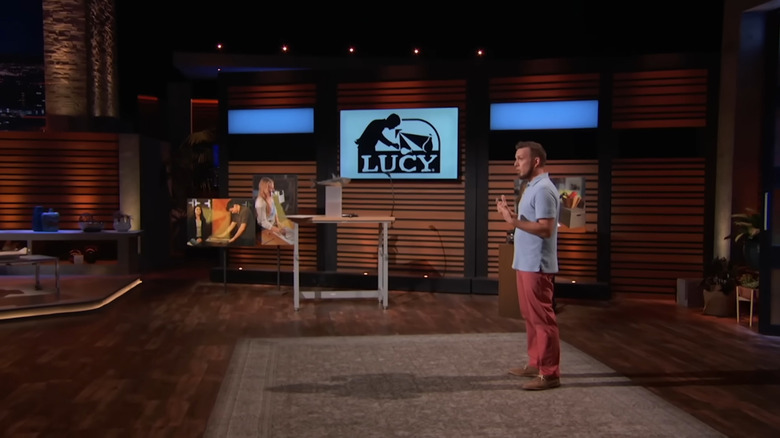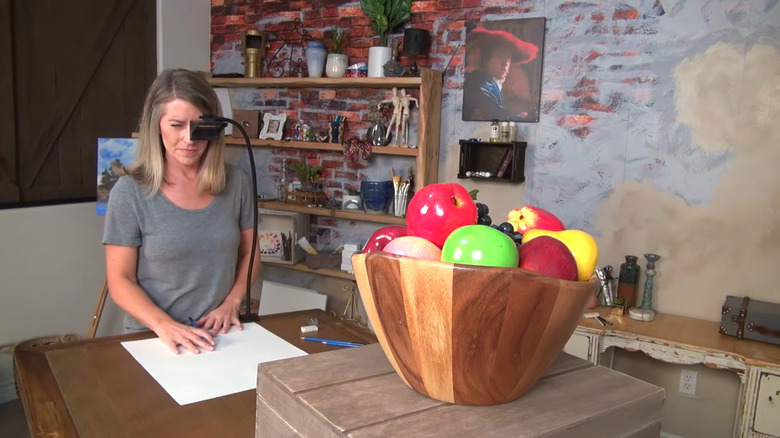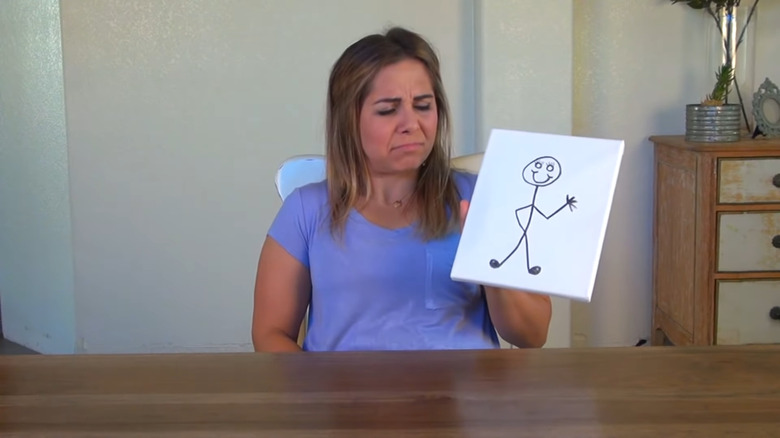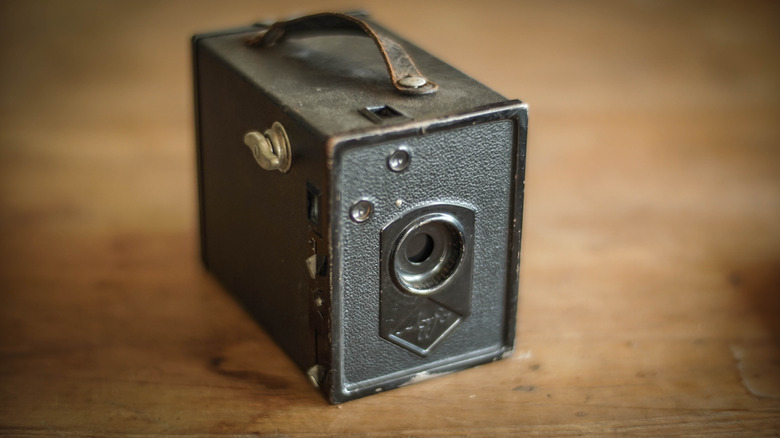Whatever Happened To The LUCY Drawing Tool After Shark Tank?
We may receive a commission on purchases made from links.
It's not often that a budding entrepreneur gets a second shot at the "Shark Tank," especially not when their first attempt involved a so-called "vomit necklace." Yet that's exactly what happened to Les Cookson when he returned to the show in Season 13, over 10 years after he failed to nab a $30,000 investment in his parenting product Carsik Bib in Season 2 — we'll spare our readers a graphic description, but it's pretty much exactly what it sounds like.
Thankfully, Cookson's second pitch needed no fluids and was targeted at a much wider age range. Called the LUCY Drawing Tool, this art device reimagined ancient technology to help even the most hapless of doodlers sketch like a master. Cookson, describing himself as a lifelong artist and inventor, had been intrigued for years by the "camera lucida," a 19th-century device that allowed artists to draw accurate representations of the subjects in front of them by using lenses and mirrors to superimpose a real image on paper. Our entrepreneur spent four years in his garage trying to update this classic tool into something modern, taking it as far as he could until he needed the sharks' help.
How Les Cookson redeemed himself on Shark Tank
For his second shot at a deal, Les Cookson aimed high, asking the celebrity investors of "Shark Tank" to invest 10 times what he sought for Carsik Bib: $300,000 in exchange for 10% of LUCIDArt, the company behind the LUCY Drawing Tool.
His flagship product works quite similarly to the camera lucida. A viewing portal (attached to an adjustable arm) with magnifying lenses and mirrors allows novice artists to see exactly what was in front of their portal on paper. As Cookson explains during the episode, it requires more skill than using tracing paper, translates to actual technical development, and can be useful to artists of all experience levels — 40% of his sales at the time were split evenly between total newcomers and professionals, with the remaining 60% lying somewhere in the middle.
The device itself is impressive enough (with Kevin O'Leary even drawing a crude shark with its help), but what really wows the investors are Cookson's solid sales numbers and sizable profit margins. By the time he appeared on "Shark Tank," he had sold $10 million worth of product. The sharks' praise is unanimously effusive, with Lori Greiner going so far as to question if he needed their help at all. Despite this, four out of the five sharks present quickly drop out, citing a lack of interest in the product and market.
As the last in the tank, Daymond John has an enviable negotiating position, though it's hard for him to push for a valuation more reasonable than what Cookson came in with. After a brief back-and-forth, John and Cookson agree to $300,000 in exchange for 15%.
Daymond John celebrated the deal after the episode aired
Immediately after the episode aired, Les Cookson and Daymond John took to social media to publicly celebrate the journey they began together on "Shark Tank." Cookson specifically took the opportunity to encourage other entrepreneurs to be persistent in their endeavors and not let failure stand in the way of their goals.
Cookson's redemption story was featured in a profile on the "Shark Tank"-affiliated outlet CNBC with the inspirational headline "11 years ago, he failed on 'Shark Tank' -– now, he has a $300,000 investment offer from Daymond John." No parties involved have disclosed whether or not LUCIDArt experienced a rush in demand after Cookson's return to ABC — though, with the prevalence of the "Shark Tank" effect, it wouldn't be surprising at all if they did.
There's also no information as of this writing on whether or not John and Cookson closed their deal, but given John's tweet and the cheerily in-depth breakdown of Cookson's "Shark Tank" experience on the LUCIDArt website, it seems things are headed in the right direction. The latter has even taken steps to expand his product line in the manner he described on the show.
LUCIDArt now offers drawing courses and new models of the LUCY Drawing Tool
During his "Shark Tank" appearance, both Les Cookson and the investors smartly identified one of the business' few weaknesses — about half the money LUCIDArt earned had to be reinvested into customer acquisition strategies. To mitigate this, Cookson wanted the sharks' help creating products that would turn those who purchased the LUCY Drawing Tool into repeat customers. One of the ideas he pitched in the room was drawing courses — the company's website now offers one for $70.
The LUCY Drawing Tool also comes in two different styles now — the "LUCY Flex" (which runs between $97 to $160, depending on when and where you purchase it) and the "LUCY mini" (a smaller, more affordable model that costs $59 to 89). They also sell numerous accessories, including a 71-piece drawing kit, a carrying bag, a "photo-enlarger," watercolor paint set, and a handsome French box easel.
Reviews of the LUCY Drawing Tool are mixed to positive
As of press time, LUCIDArt is still in business, and the company is still selling a wide range of products. Most of what they offer is currently discounted, including the drawing course, which can be bought for $47 instead of $70. On their website, a testimonial reads: "THE LUCY DRAWING COURSE SHOWED ME THAT I CAN LEARN TO DRAW!"
On Amazon, their flagship device has an average customer rating of 3.5 stars out of 5, based on over 360 reviews. Based on its features, it has an average of around 3/5 for steadiness and accuracy, but around 2.5/5 for value-for-money, ease of use, and "giftability." Multiple customers have dismissed it as a waste of cash that, among other things, needs perfect lighting to operate properly. The highest-rated reviews are generally positive, though they too often admit the need for specific lighting, as well as the product's inability to instantly make one a master of sketch work. LUCIDArt also has competition on the site in NeoLucida, which offers its own versions of the "flex" and "mini" LUCY tools for significantly less money, though they have middling reviews as well.
The future of LUCIDArt is in the past
If LUCIDArt wants to stay on top of the market, Les Cookson might need to improve his product and expand his offerings. While there's no evidence of the former, he already has a stable of reimagined classic devices ripe to be polished and presented to his post-"Shark Tank" consumer base.
Cookson has made two major attempts at reviving the rudimentary filmmaking device known as the zoetrope, another 19th-century device that allows one to watch a spinning ring of sequential images that creates the illusion of movement — which isn't actually that far from how modern films work. Cookson's "ZOEFLIX" is essentially a zoetrope made from modern materials and bolstered by an LED light. The Animation Dome, meanwhile, is a more ambitious, brightly colored version of the device aimed at children and boasting the capability to create 3D images using toys such as miniature figurines or LEGOs.
Cookson's most successful project outside the LUCY Drawing Tool appears to be his modern take on the Camera Obscura. Like the ZOEFLIX, Cookson's Camera Obscura operates similarly to how the original did and has instead been crafted with modern materials. When he took the project to Kickstarter in 2019, he raised $18,115. Perhaps by taking a new look at his old projects — with the fresh eyes of a "Shark Tank" partner — Cookson can keep LUCIDArt profitable and prosperous.





